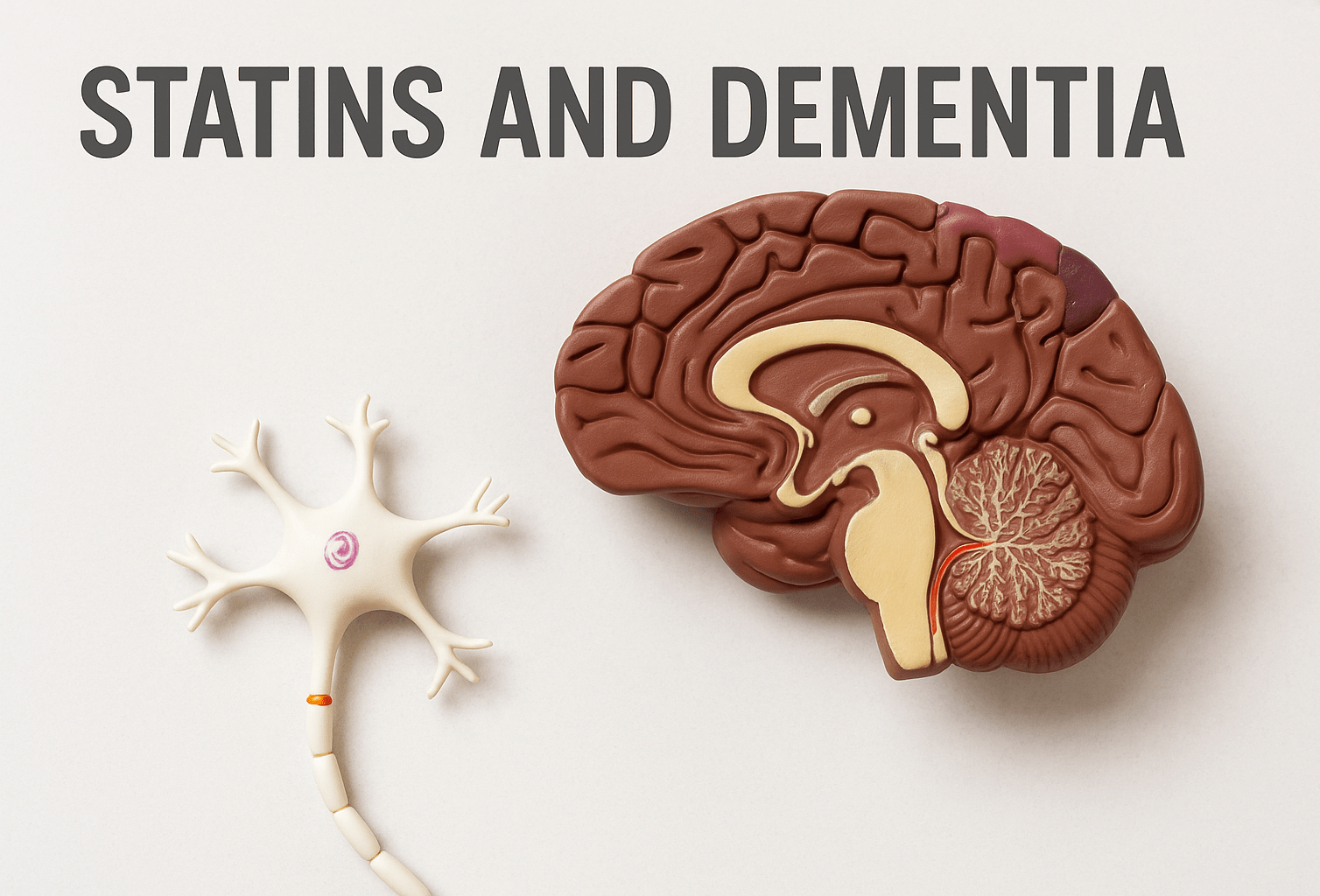Do Statins Influence The Risk of Dementia?
Introduction
Dementia refers to a group of disorders that result in brain dysfunction, including difficulty with memory, behavior, and the ability to carry out daily activities. Dementia is not a single disease, but rather a group of neurologic disorders that exceed the expected changes of normal aging. Given its profound impact on human health and quality of life, identifying risk factors of dementia is an important consideration for those seeking to promote longevity. Meanwhile, cardiovascular disease remains the leading cause of death in adults, and statins are among the most widely prescribed medications used to reduce cardiovascular risk. While statin therapy has been shown to slow the progression of atherosclerosis and reduce the incidence of heart attack and stroke,1,2 statins have also emerged as a subject of controversy and concern due to a possible increased risk of dementia.3-6
The relationship between statin therapy and brain health is complex. Cholesterol is necessary for normal brain function, including the formation and maintenance of healthy brain cells, development of neural connections, protection of nerve fibers with myelin, and production of neurosteroids. For context, the brain contains nearly 25% of the body’s total cholesterol, despite representing only 2% of body weight.13 Given cholesterol’s essential role in brain function, it is reasonable to question whether statins might influence cognitive function or dementia risk. Researchers have investigated several mechanisms by which statins may theoretically contribute to neurologic dysfunction. These include altered brain cholesterol homeostasis, coenzyme Q10 depletion and increased oxidative stress, reduced neurosteroid production, impaired clearance of misfolded proteins such as amyloid-β and tau, and drug-drug interactions that may negatively affect cognitive function.
While some observational studies have reported an increased risk of dementia with certain types of statin therapy,particularly lipophilic statins,3-6 a larger body of observational evidence suggests that statins are associated with a reduced risk of dementia.7-10 Statins improve vascular health and reduce atherosclerosis, both of which are relevant to the development of vascular dementia.1,2 Additional studies suggest that statins may reduce neuroinflammation and oxidative stress,11,12 and may also influence the buildup of amyloid and tau proteins, both of which are implicated in the development of Alzheimer’s disease.14,15 Given the inconsistency of findings from observational data, and the limitations inherent in such studies, this article will focus on higher-quality evidence to address the central question, does statin therapy increase, decrease, or have no effect on the risk of dementia?
To answer this question, this article will examine evidence from randomized controlled trials, Mendelian randomization studies, and populations with lifelong exposure to extremely low LDL-C levels due to genetic conditions such as familial hypobetalipoproteinemia or PCSK9 loss-of-function mutations. This article will also evaluate cognitive outcomes from trials involving PCSK9 inhibitors, which lower LDL-C levels to very low values, often below 40 mg/dL, through a different mechanism than statin therapy. Finally, we will explore important clinical considerations, including differences between lipophilic and hydrophilic statins, the intensity of statin dosing, and individual risk modifiers such as age, family history, and APOE genotype.
Related Podcast Episode
Disclaimer
This content is intended for general educational purposes only and does not represent the practice of medicine, medical advice, diagnosis, or treatment. Reading or interacting with this content does not establish a physician–patient relationship. All individuals should discuss with their personal healthcare provider before making any changes to their diet, lifestyle, medications, or other aspects of their health. Additionally, I have no financial relationships or affiliations with any diagnostic labs, supplement companies, or pharmaceutical manufacturers mentioned in this article.
Notify Me of New Content
Provide your email address to receive notifications of new blog posts and podcast episodes.
Content Summary
What the Evidence Shows
Practical Conclusions
What Is Dementia
Dementia refers to a group of disorders that result in brain dysfunction, typically presenting as a progressive decline in memory, behavior, and the ability to carry out normal daily activities. While mild cognitive changes are common with aging, dementia reflects a pathological degree of brain dysfunction that exceeds what would be expected from normal aging.
Importantly, dementia is not a single disease but a syndrome of various underlying conditions resulting in neurologic dysfunction. The type of dementia is typically categorized based upon the cause, the region of the brain involved, and the pattern of associated symptoms. Although many forms of dementia share overlapping features, each has distinct risk factors, progression, and clinical presentation. Furthermore one’s genetic susceptibility plays a particularly influential role in the development of several types of dementia. However, it is also necessary to acknowledge that much about the pathophysiology of dementia remains poorly understood and significant advances in prevention and treatment are still needed.
For those demonstrating early signs of cognitive impairment, an early and thorough medical evaluation is essential, as some conditions that present similarly to dementia may be partially or fully reversible with appropriate treatment.
Table 1. Categories and Clinical Presentation of Dementia
| Dementia Type | Brief Description | Common Symptoms | Prevention Focus |
| Alzheimer’s Disease | Most common cause of dementia, accounting for approximately 65% of cases | Gradual decline in short-term memory, followed by language difficulties and impaired judgment | 1. Cardiovascular health 2. Cardiorespiratory fitness 3. Insulin resistance 4. Social interaction 5. Optimal sleep 6. Education level 7. Hearing loss correction |
| Vascular Dementia | Second most common; results from strokes or chronic cerebrovascular disease | Symptoms vary based on location and severity of brain injury; may follow a stepwise rather than gradual course | 1. Blood pressure control 2. Lipoprotein management 3. Insulin resistance 4. Cardiorespiratory fitness 5. Smoking cessation |
| Lewy Body Dementia | Caused by abnormal accumulation of alpha-synuclein protein (Lewy bodies) | Visual hallucinations, fluctuating cognition, sleep disturbances, Parkinsonian motor symptom | Supportive care; no definitive prevention known |
| Frontotemporal Dementia | Progressive degeneration of frontal and/or temporal lobes; more common before age 65 | Early changes in behavior, judgment, or language; memory often spared in early stages | No proven prevention; some genetic risk factors identified |
| Mixed Dementia | Combination of two or more forms, commonly Alzheimer’s and vascular | Mixed symptoms; variable progression and overlap of features | Risk factor management as outlined above |
| Secondary Dementias | Potentially reversible conditions mimicking dementia | May include depression, hypothyroidism, alcohol misuse, medication effects, B12 deficiency, hydrocephalus | Prompt recognition and treatment of underlying cause |
Understanding Statins and Brain Cholesterol Metabolism
Statin therapy works by inhibiting the enzyme HMG-CoA reductase, a key component of the liver’s cholesterol synthesis pathway. The inhibition of HMG-CoA reductase reduces the production of cholesterol in the liver and also leads to an upregulation of LDL receptors on the liver, which help to clear ApoB-containing lipoproteins from the bloodstream, including LDL particles.
Notably, cholesterol metabolism in the brain is distinct from that of the rest of the body due to the presence of the blood-brain barrier. The blood-brain barrier is a highly selective boundary that separates the central nervous system (CNS) from the peripheral circulation. It is impermeable to most circulating lipoproteins, cholesterol, and many medications. As a result, the brain must create nearly all of its own cholesterol locally within the CNS to support essential neurologic functions such as myelin formation, synapse development, and neurotransmitter signaling.13
Statins exert their primary effect outside the CNS, inhibiting cholesterol production in peripheral tissues.34 However, the ability of statins to influence brain cholesterol metabolism is influenced by their chemical properties, particularly their lipophilicity. Hydrophilic statins (e.g., rosuvastatin, pravastatin, pitavastatin) are water-soluble and have limited ability to cross the blood-brain barrier, and primarily exert the effect on the liver. In contrast, lipophilic statins (e.g., atorvastatin, simvastatin, lovastatin) are fat-soluble and can more readily enter the CNS, potentially influencing brain cholesterol metabolism. This difference may be relevant when considering cognitive effects, as lipophilic statins theoretically pose a higher risk of impacting brain function (Table 2).
Despite the ability of lipophilic statins to enter the brain, current evidence suggests that HMG-CoA reductase within the CNS is regulated differently than HMG-CoA reductase outside of the CNS.13 Furthermore, studies indicate that the level of HMG-CoA reductase inhibition achieved in the brain by statin therapy is typically insufficient to significantly impair cholesterol synthesis in the CNS.16 However, concerns remain that high-dose, lipophilic statins may exert greater effects on CNS cholesterol metabolism, potentially contributing to adverse neurologic outcomes in susceptible individuals.35
Table 2. Statin Classification by Blood-Brain Barrier Permeability
| Statin Type | Examples | CNS Penetration | Primary Site of Action |
| Hydrophilic | Rosuvastatin, Pravastatin, Pitavastatin | Limited penetration | Primarily peripheral tissues |
| Lipophilic | Atorvastatin, Simvastatin, Lovastatin, Fluvastatin | More likely to cross the blood-brain barrier into CNS | Both peripheral and possible CNS |
Notes: Central nervous system (CNS).
Mechanistic Pathways by Which Statins May Increase the Risk of Dementia
While high-quality clinical trials are necessary to establish causality, exploring biological mechanisms can help understand how statins might affect brain health, either positively or negatively. This section outlines theoretical pathways through which statins could contribute to cognitive decline. These include potential effects on cholesterol metabolism in the brain, mitochondrial function, neurosteroid production, amyloid clearance, and drug interactions among individuals taking multiple medications. The next section will explore proposed mechanisms of cognitive protection.
Table 3. Mechanisms by Which Statins May Increase the Risk of Dementia
| Mechanism | Description |
| Depletion of CNS Cholesterol | Lipophilic statins may cross the blood-brain barrier and inhibit cholesterol synthesis within the brain, potentially impairing synapse formation, membrane stability, and neuronal signaling.36-38 |
| Mitochondrial Dysfunction & CoQ10 Loss | Statins reduce coenzyme Q10 (CoQ10) production, which may impair mitochondrial energy metabolism and increase neuronal oxidative stress.39-42 |
| Reduced Neurosteroid Synthesis | Cholesterol is a precursor for neurosteroids, which modulate mood, cognitive function, and neuroprotection; reduced availability may negatively affect central nervous system function.45,46 |
| Impaired Microglial Amyloid-β Clearance | Statins may suppress microglial activity, potentially hindering amyloid-β clearance and promoting plaque accumulation, particularly in genetically susceptible individuals.50 |
| Polypharmacy & Drug Interactions | Statins that are metabolized by CYP450 enzymes may interact with other medications, increasing the risk of neurotoxic effects, especially in older adults taking multiple medications.51 |
Mechanistic Pathways by Which Statins May Decrease the Risk of Dementia
While concerns exist about potential adverse effects relating to statin therapy and cognitive function, there are also compelling biological mechanisms suggesting that statins may reduce the risk of dementia. These mechanisms include vascular protection, anti-inflammatory effects, improved cerebral perfusion, and modulation of amyloid and tau pathology. Collectively, they offer a theoretical basis for how statin therapy might preserve cognitive function and reduce the incidence of dementia.
Table 4. Mechanisms by Which Statins May Decrease the Risk of Dementia
| Mechanism | Description |
| Vascular Protection | Statins lower LDL and ApoB levels, systemic inflammation, risk of atherosclerosis, stroke, and cerebral small vessel disease, all of which are major risk factors of vascular and mixed dementia. 1,2,52,53 |
| Improved Cerebral Perfusion | Statins help improve blood vessel function and overall vascular health, which can enhance blood flow and oxygen delivery to the brain. This improved circulation may help protect vulnerable brain regions from injury.54,55 |
| Anti-Inflammatory Effects | Statins reduce pro-inflammatory cytokines and may downregulate microglial activation, potentially slowing neuroinflammation and associated injury.11,12 |
| Reduced Amyloid-β Deposition | Statin therapy may enhance amyloid beta involved altered processing of Aβ clearance through its effects on amyloid beta precursor protein.14,48,49 |
| Tau and Synaptic Support | Statins may reduce tau phosphorylation and increase synaptic protein expression, potentially preserving neuronal structure and protecting against tau-related neurodegeneration.15 |
Evaluating the Evidence: Do Statins Influence the Risk of Dementia?
Observational studies have produced mixed and often conflicting results regarding statin use and dementia risk. Some report increased cognitive impairment, while others suggest a protective effect, or no association at all. However, observational studies are inherently limited by confounding factors and cannot establish causality. To better understand whether statin therapy truly influences dementia risk, we must turn to more rigorous forms of evidence. The following sections will examine randomized controlled trials (RCTs), Mendelian randomization studies, and data from individuals with lifelong or treatment-induced low LDL-C levels. Together, these sources offer a more reliable and comprehensive evaluation than observational data alone.
Evidence from Observational Studies
Several observational studies have reported an increased association of cognitive impairment and progression to dementia with statin therapy.3-6 Meanwhile, there is a significantly larger body of evidence from observational studies demonstrating a protective effect of statin therapy and cognitive impairment new onset dementia,7-10 as well as a significant body of evidence demonstrating no harmful or protective effect. Notably, among the limited number of observational studies demonstrating an increased association of cognitive impairment, dementia, and statin therapy, all studies implicate lipophilic statin therapy (e.g. Atorvastatin, Simvastatin, etc.), with no harmful association reported with hydrophilic statin therapy (e.g. Rosuvastatin, Pravastatin, etc).3-6 As previously stated, observational studies cannot establish causation and should not be considered conclusive. Instead, these findings should be interpreted in the context of more rigorous evidence from randomized trials and genetic analyses.
Evidence from Randomized Clinical Trials
Although observational studies have suggested that statins may influence the risk of dementia, data from randomized clinical trials (RCTs) have not supported this conclusion. To date, RCTs show that statin therapy does not increase the risk of cognitive decline, nor does it consistently prevent the onset or progression of dementia.
In a small trial of 308 adults with abnormal cholesterol levels, simvastatin was associated with modest declines on select neuropsychological test results compared to placebo.17 However, most cognitive domains were unaffected, and the findings reflected a lack of improvement rather than measurable decline. The clinical relevance of these changes remains unclear.
Larger trials have provided more definitive evidence. The PROSPER trial, which followed 5,804 older adults for 3.5 years, found no difference in the rate of cognitive decline between the pravastatin and placebo groups, suggesting no adverse cognitive effect, but also no evidence of cognitive protection.18 Similarly, the Heart Protection Study enrolled over 20,000 individuals and found no differences in cognitive outcomes between those receiving simvastatin and those receiving placebo over five years of follow-up.19 The HOPE-3 trial, which evaluated rosuvastatin in 1,626 participants over 5.6 years, also found no effect on cognitive or functional decline, indicating neither harm nor benefit.20
These results are consistent with a 2016 Cochrane review of 11 RCTs, which concluded that statins do not prevent dementia or cognitive decline in older adults at risk of vascular disease. Importantly, the review also found no increase in cognitive side effects.21 “Statins given […] to people at risk of vascular disease do not prevent cognitive decline or dementia. Biologically, it seems feasible that statins could prevent dementia due to their role in cholesterol reduction and initial evidence from observational studies was very promising. However, […] evidence from subsequent RCTs has been negative.”
In summary, high-quality randomized trials consistently demonstrate that statins do not increase the risk of cognitive impairment, but they also fail to show a protective effect against dementia or cognitive decline. These findings support the neurologic safety of statin therapy when used for cardiovascular risk reduction. While some observational studies have reported potential adverse effects, particularly with lipophilic statins, these findings have not been replicated in randomized trials. For individuals with cognitive concerns, hydrophilic statins remain a reasonable alternative, especially in the context of elevated cardiovascular risk.
Importantly, several limitations of the current trial data must be acknowledged. Most studies had follow-up durations of only 3 to 6 years, which may not capture cognitive changes that emerge slowly over time. Additionally, many trials relied on general cognitive screening tools rather than sensitive or disease-specific assessments, potentially underestimating subtle effects in at-risk populations. As such, both cognitive benefit and harm remain possible over longer durations or in specific subgroups.
To build on the evidence from randomized trials, the following sections will explore complementary lines of data from individuals with lifelong genetically low LDL-C, the effects of PCSK9 inhibitor trials that achieve very low levels of LDL, and causal insights from Mendelian randomization studies.
Genetic Conditions That Cause Low Levels of LDL-C
Beyond randomized clinical trials, additional insight can be obtained from the investigation of individuals who naturally maintain very low LDL cholesterol levels throughout their lifetime due to genetic mutations. Loss-of-function mutations in the PCSK9 gene, which consistently lower LDL-C levels below 50 mg/dL, are associated with reduced cardiovascular risk but show no significant difference in dementia incidence, age of onset, or cognitive decline, regardless of APOE status or sex.22,23
Similarly, individuals with familial hypobetalipoproteinemia (FHBL) typically have lifelong LDL-C levels below 30 mg/dL. Despite these extremely low levels, their performance on neurocognitive tests, including measures of executive function, memory, and processing speed, appears comparable to individuals without the condition.24 Brain MRI findings are also similar between groups, suggesting that persistently low LDL-C is neither associated with cognitive impairment nor confers measurable neuroprotection.
Taken together, these findings indicate that very low LDL-C levels throughout life are not associated with an increased risk of cognitive decline. However, there is also no strong evidence that having lifelong low LDL-C levels protects against dementia or age-related cognitive decline.
Drug-Induced LDL Lowering: PCSK9 Inhibitor Trials
Data from PCSK9 inhibitor trials provide reassuring evidence of the neurologic safety of very low levels of LDL-C using prescription medications. In a large pooled analysis of 4,425 participants from the FOURIER and FOURIER-OLE trials, use of the PCSK9 inhibitor evolocumab led to sustained LDL-C reductions to levels as low as 20–30 mg/dL over a median of 5.1 years, with no increase in adverse cognitive outcomes compared to placebo.25 Cognitive function was assessed using the Everyday Cognition (ECog) scale, which showed no meaningful differences in memory, language, or executive function across LDL-C strata, including those with the lowest values (<20 mg/dL).
Mendelian Randomization Studies
Mendelian randomization offers a valuable genetic approach to evaluating the long-term effects of lower LDL cholesterol on the risk of dementia. In a large study of over 111,000 individuals, genetic variants in the PCSK9 and HMGCR genes were not associated with an increased risk of Alzheimer’s disease, vascular dementia, or Parkinson’s disease.26 While there was a modest signal suggesting potential protection against Alzheimer’s disease, no such effect was observed for vascular dementia. Similar results were reported in a separate analysis using UK Biobank data, where polygenic scores for LDL-C and variants in PCSK9 and APOB showed no significant associations with dementia diagnoses or cognitive performance.27 Collectively, these findings indicate that genetically lower LDL-C is not causally linked to an increased risk of cognitive impairment. Although some analyses suggest a potential protective effect for Alzheimer’s disease, the overall evidence does not support a strong harmful or beneficial impact of low LDL-C on cognitive outcomes.
Summary and Interpretation
Across multiple lines of evidence, including randomized trials, Mendelian randomization studies, and long-term pharmacologic LDL-lowering, there is consistent data to support the neurologic safety of statin therapy.17-27 While a subset of observational studies have raised concern about potential adverse neurologic effect of lipophilic statins,3-6 these findings have not been validated or reproduced in randomized controlled trials.17-21 Instead, randomized controlled trials have shown no meaningful increase in cognitive decline or protection against dementia with statin use. These negative results may be due to short follow-up durations and the use of general rather than disease-specific cognitive assessments. Meanwhile, when evaluating data from other methodologies of scientific research, there still remains no compelling evidence that statin therapy meaningfully influences the risk of dementia, favorably or unfavorably.22-27
In summary, current evidence does not support either a harmful or protective role of statins in relation to cognitive health. Statins appear neurologically safe for individuals with elevated cardiovascular risk, and although long-term effects cannot be entirely ruled out, the overall body of evidence is reassuring. It remains possible that statin therapy could reduce the risk of dementia or progression over a longer timeframe than current studies capture, but this remains speculative. Future research with extended follow-up and more sensitive cognitive assessments may help determine whether specific subgroups experience cognitive benefit, or harm, from statin use.
Practical Conclusions
- Statins do not appear to meaningfully influence the risk of dementia. The best available evidence, including randomized trials, genetic studies, and trials of LDL-lowering medications, shows no increase in cognitive impairment with statin use, but also no consistent protective effect of low LDL-C levels. While some studies suggest a modest benefit in certain types of dementia, these findings are inconsistent and not supported across multiple lines of evidence.
- Statin prescriptions should be guided by cardiovascular benefit, with reassurance of overall neurologic safety. The cognitive safety of statins is well supported by the existing body of evidence, and concern about the risk of dementia should not prevent appropriate use of statin therapy in patients with elevated cardiovascular risk.
- Hydrophilic statins (e.g. rosuvastatin, pravastatin) may be preferred for individuals at higher risk of, or particularly concerned about, dementia, due to their limited penetration into the central nervous system. However, this remains a theoretical advantage, as current evidence does not clearly support a cognitive safety difference between statin types.
- High-intensity statins should be reserved for individuals with high cardiovascular risk. In individuals with lower-risk or those without established cardiovascular disease, it may be more appropriate to use low- or moderate-intensity statins as well as non-statin therap55ies, such as ezetimibe, bempedoic acid, or PCSK9 inhibitors, to achieve lipid targets while minimizing unnecessary exposure to high-intensity statin therapy.
- LDL-C does not appear to be a promising target for dementia prevention. Despite mechanistic plausibility, especially for vascular dementia, clinical evidence does not support that lowering LDL-C reduces the risk of cognitive decline.
- Future research should focus on risk stratification, particularly among APOE4 carriers, individuals with vascular comorbidities, and those showing early signs of cognitive decline. In reviewing the literature for this article, I found no clinical studies that evaluated cognitive outcomes from statin therapy stratified by APOE genotype. Although some have advocated for avoiding statins in APOE4 carriers, this recommendation appears to be based on theoretical concerns rather than evidence from clinical research.
- Optimizing metabolic health and other lifestyle factors remain central to protecting neurological health and the pursuit of longevity. Hypertension, obesity, insulin resistance, physical inactivity, and alcohol misuse, appear to be stronger and more actionable targets for dementia prevention than LDL-C levels.28-33
- In patients presenting with cognitive symptoms, prompt and comprehensive evaluation for reversible causes is essential, as timely initiation of evidence-based therapies may significantly improve cognitive and functional outcomes. For those diagnosed with vascular dementia, aggressive management of modifiable risk factors, such as hypertension, stroke prevention, and atrial fibrillation, is critical to slowing disease progression. Additionally, FDA-approved therapies are available for other dementia subtypes and should be considered based on the specific clinical context.







